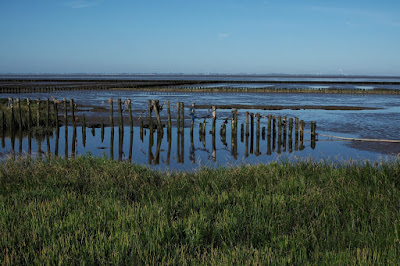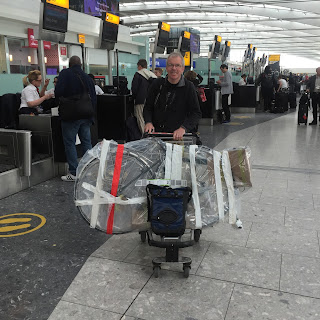I have a problem with museums and art galleries. The moment I walk in through the door I start to feel tired, and by the time I leave I feel more exhausted than I do after cycling 100km. The
Klimahaus in Bremerhaven is an exception.
 |
| Looking across the Weser towards Wilhelmshaven |
I left the campsite in the morning and cycled along the bank of the Weser river towards Bremerhaven's vast container port, passed by a constant stream of ships heading to the docks. The cycle route weaves through the port and emerges right in the centre of the city between the Tourist Information and the Klimahaus itself. I asked in the Tourist Info if there was anywhere to leave my bike and they pointed across the piazza and told me to go down into the underground carpark. The man in the office there saw me coming and pointed to the bicycle park. I was able to wheel my bike, luggage and all, into a container large enough for two bikes which cost just 1 euro for the day. Just imagine if this was available in every town and city, how much easier life would be.
 |
| Klimahaus |
So, free from worry about bike and luggage, I strolled into the museum, or maybe I should call it an 'experience'. The Klimahaus is an amazing combination of art installation, science museum, aquarium and theme park - and other things besides. It was full of school parties, but that didn't seem to matter. In fact, it was astonishing to see how engaged all of the visitors were, whatever their ages.
 |
| The start of the journey |
You enter as a group and watch a short movie about an artist starting out on a journey from Bremerhaven around the line of 8 degrees of longitude. The film shifts to a model railway travelling against a backdrop of photographs and at some point you notice that there are real railway tracks beneath your feet. The Klimahaus is inventive throughout. In each section there are filmed interviews with people who live in the locations, together with artefacts, photographs and artworks. Not to mention rides and recreations of the places: walls and sheets of ice; a recreation of ten square metres of the Niger desert in 35 degree heat; the sounds and smells of the Cameroon rain forest at night; a stretch of Antarctic ice in a chilly -6 degrees. Then at the end a visit to Langeneß, an island in the Waddenzee; a place particularly vulnerable to changes in sea-level.
 |
| Niger |
It would be easy to spend a whole day in the Klimahaus. I was there for a few hours and then I took a ferry across the Weser river and camped for the night at Fedderwardeseil, looking a few kilometres across the Weser to the place I'd camped the night before.
 |
| Fedderwarderseil |
I was now in the heart of the setting for Erskine Childers' 1903 espionage novel The Riddle of the Sands. It has one of the most powerful evocations of landscape of any novel I've read. I would be spending the next few days travelling through this landscape, so I got out the book and started to read.
The map is here:
Fedderwarderseil







Comments
Post a Comment